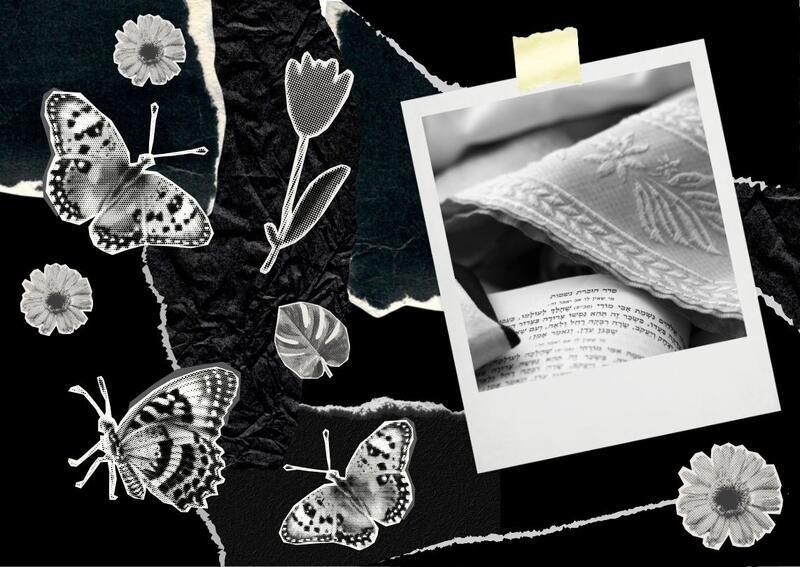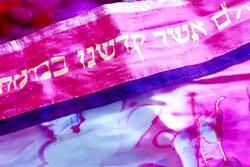Praying for Permanence: Finding My Connection to Faith
Eight-stranded braids are my specialty. I developed this skill during long Saturday prayer services, making the white tzitzit on my father’s tallit into my own fidget toy. I found comfort in taking these strands and making my own designs, using a garment so integral to my father and making it mine—briefly. I would always look forward to services, to play with these strings and sing alongside my father, harmonizing to the t’filot. In this routine, I felt safe.
In many ways, his faith prompted my own. Seeing the joy that Jewish ritual brought him made me seek it myself. I taught myself prayers and Torah trope, always trying to learn more. I reveled in the permanence promised by faith: these traditions began long before I was here and will continue long after I am gone.
One day, I noticed that the knots on my father’s tallit were unraveling and beginning to fray—he had long needed to replace the strings—and I asked if I could retie them. Carefully, I made a series of knots as my father looked on, a small smile on his face. In remaking these knots, I felt that I was leaving an imprint.
I was afraid to take my own leap, however, and shoulder the tradition of my father. With my bat mitzvah came the offer of a tallit of my own from my parents, with strong encouragement from my school and synagogue. I was proud to be Jewish, but I was perpetually afraid of doing things I couldn’t take back. What if I just wanted to sleep in one day and missed the time frame for prayer? Would that make me a terrible Jew? That promise of permanence felt overwhelming. Could I commit at age twelve to daily prayer for the rest of my life? I donned a tallit when requested, but I was unwilling to take ownership of this practice myself, making it unchanging.
My struggle to express my own Jewish identity grew with time. As I got older, my service attendance at my father’s shoulder became inconsistent. I chose to spend my Saturday mornings asleep, blissfully oblivious to the world. I began using electronics on Shabbat, prioritizing my connection with friends over the connection offered by religion. I began reading the liturgy of my siddur critically, disturbed by contradictory messages I saw. My record of permanence was breaking down: my beliefs were changing. Despite Judaism’s promise of continuity, I was losing interest in its stories. My practices were shifting, too, leaving me unmoored. I no longer knew what it meant to be Jewish. Was it the diligent prayer of my father? The casual observance of my friends, attending synagogue but in name only, spending services debriefing school scandals? Neither felt fully resonant; neither were safe anymore.
The past four years have been an exploration of finding meaning in faith. I’ve had Shabbats without technology, fully embodying the day of rest, and ones with calculus study as my only source of vaguely divine inspiration. I have attended rallies that have felt more meaningful than any text study. I have shown up in a foreign country on the steps of a Chabad hoping for any semblance of a service, only to be turned away. I have written my own nigunim and led the occasional song.
Slowly, I have come to understand that my connection to Judaism doesn’t need to be a linear path. I experience days of doubt, times of radiant joy, and moments of deep guilt. My observance ebbs and flows with my schedule and my mood. I perpetually badger others with many questions, but if that isn’t Judaism, I don’t know what is. My search for answers is ongoing, and my grappling doesn’t rob my faith of its endurance.
Now, instead of carrying a prayer shawl to synagogue, I come bearing books of poetry. The shared themes of resilience and art found in both texts resonate with me deeply, even when I struggle to connect to liturgy. I read stanzas of poetry alongside p’sukim of the Torah and hold them side by side, reveling in the holiness of expression across generations and mediums. I explore commentaries, midrashim, and songs in sidebars of the siddurim. Typically, I walk away with more questions than answers, but, instead of inducing panic, it provides a segue into discourse with family and friends.
My father and I still harmonize at shul, though sometimes I sleep in instead. Occasionally, I return to the braiding, twisting the eight strands with more difficulty now, just to see if I can. All these years later, the tzitzit I made for him remain intact, a reminder of our connection. The knots hold strong, and that is growing to be enough.
This piece was written as part of JWA’s Rising Voices Fellowship.







